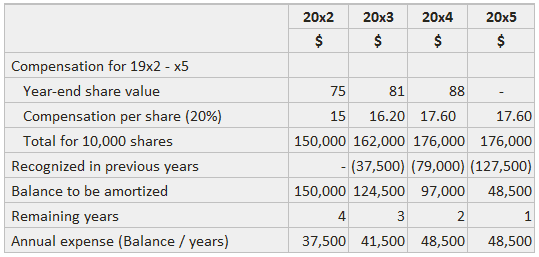Rather than offering shares or warrants to employees, many companies grant stock appreciation rights (SAR). Under these arrangements, employees do not have to buy shares but are rewarded just as if they owned them. For example, an executive might be entitled to receive a cash payment after four years amounting to the increase in the value of 10,000 shares of stock. As an alternative, part or all of the compensation might be paid with shares. In accounting, the process that the company uses to record SAR agreements is to accrue a liability and recognize expense over the term of service. At the end of the service period, the liability is settled in cash or stock (or both). Let's consider an example of calculating the annual expense under a plan offered by the Sample Company. An agreement is established on 31 December 2018 stating that employees will receive cash payments on 2 January 2023 amounting to the difference between the present market value of 10,000 shares and their value on 31 December 2022. For employees to receive the SAR, they must work for the Sample Company for the whole period of four years. The first calculation depends on an estimate of the total compensation for the plan based on the year-end stock value. This amount is adjusted for previous charges, and the balance is spread over the remaining life. This is shown in the example below. The journal entries at the end of each of the four years are presented below: It is worth noting that this approach to estimating the expense can result in a negative expense. This occurs when the market value rises and then falls such that the prior years' charges exceed the net appreciation to date. In this example, there would be a debit to the liability and a credit to compensation expense if the ending market value per share in 2022 falls below $33.


Stock Appreciation Rights (SAR) FAQs
Stock appreciation rights (SARs) are a type of equity compensation that gives the holder the right to receive cash or stock equal to the appreciation in the value of a specified number of shares of company stock over a specified period of time.
The original amount of the liability is split according to the total service period. In this case, it would be four years. The compensation expense each year reflects a different portion of the liability and is based on changes in stock value over that period. This also means the income statement may have a negative or positive amount at the end of each year.
The holder of SARs is typically granted a specified number of shares of company stock, which are set aside in a trust or escrow account. At the end of the vesting period, if the stock price has increased, the holder receives cash or stock equal to the appreciation in value. If the stock price has decreased, no payment is made.
There are a few key benefits of SARs: -They provide an incentive for the holder to help increase the stock price since they will directly benefit from any appreciation. -They can be structured so that the holder does not have to pay taxes on the appreciation until the SARs are actually exercised. -SARs can be granted to employees, directors, and consultants, providing a broad base of people who have an incentive to help grow the company.
Like any equity compensation, there are a few potential drawbacks to consider with SARs: -If the stock price decreases, the holder may end up being underwater on their investment. -SARs can be complex to value and account for, which may require the assistance of a financial advisor. -There may be vesting requirements or other conditions that must be met before the SARs can be exercised.
True Tamplin is a published author, public speaker, CEO of UpDigital, and founder of Finance Strategists.
True is a Certified Educator in Personal Finance (CEPF®), author of The Handy Financial Ratios Guide, a member of the Society for Advancing Business Editing and Writing, contributes to his financial education site, Finance Strategists, and has spoken to various financial communities such as the CFA Institute, as well as university students like his Alma mater, Biola University, where he received a bachelor of science in business and data analytics.
To learn more about True, visit his personal website or view his author profiles on Amazon, Nasdaq and Forbes.











